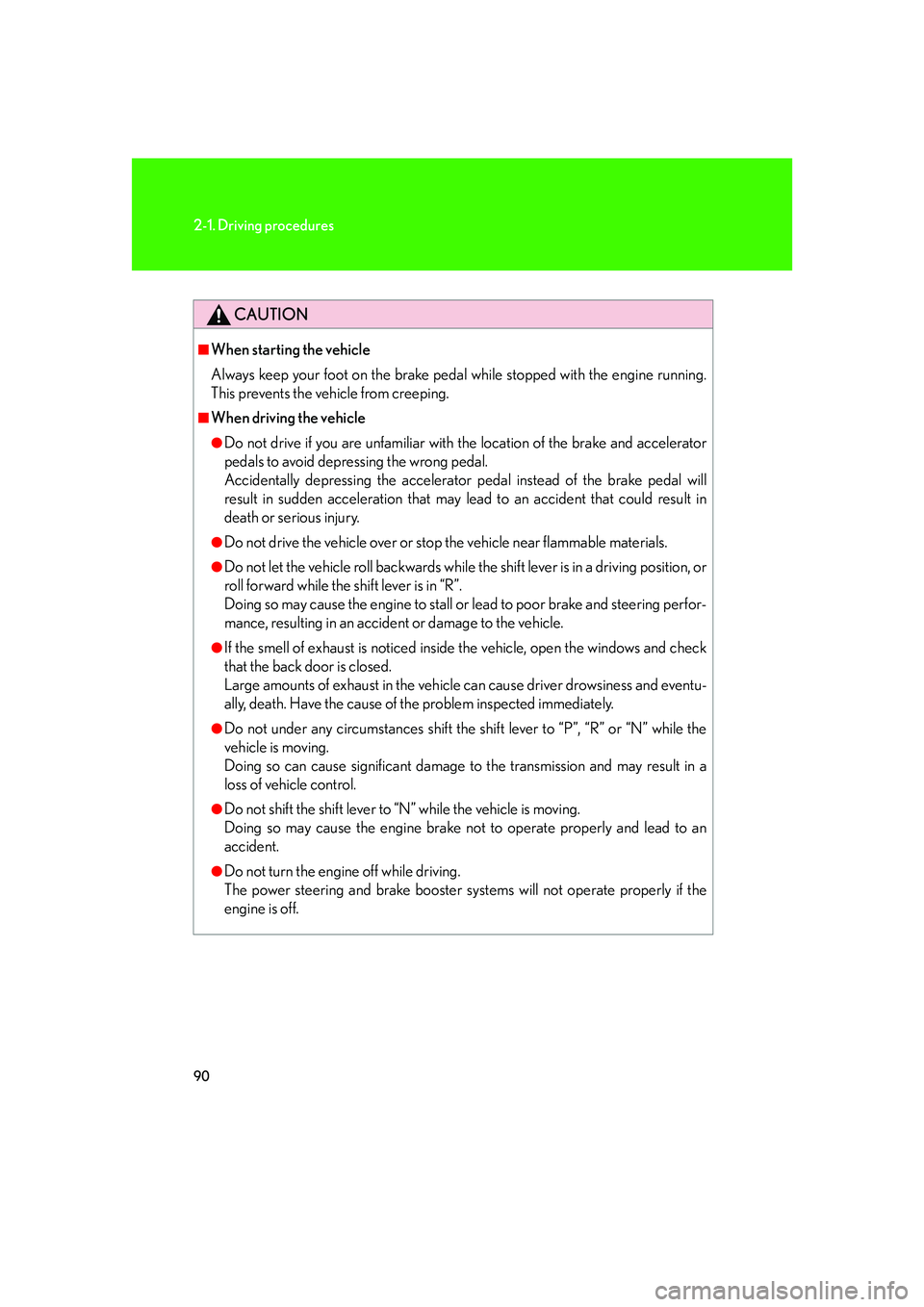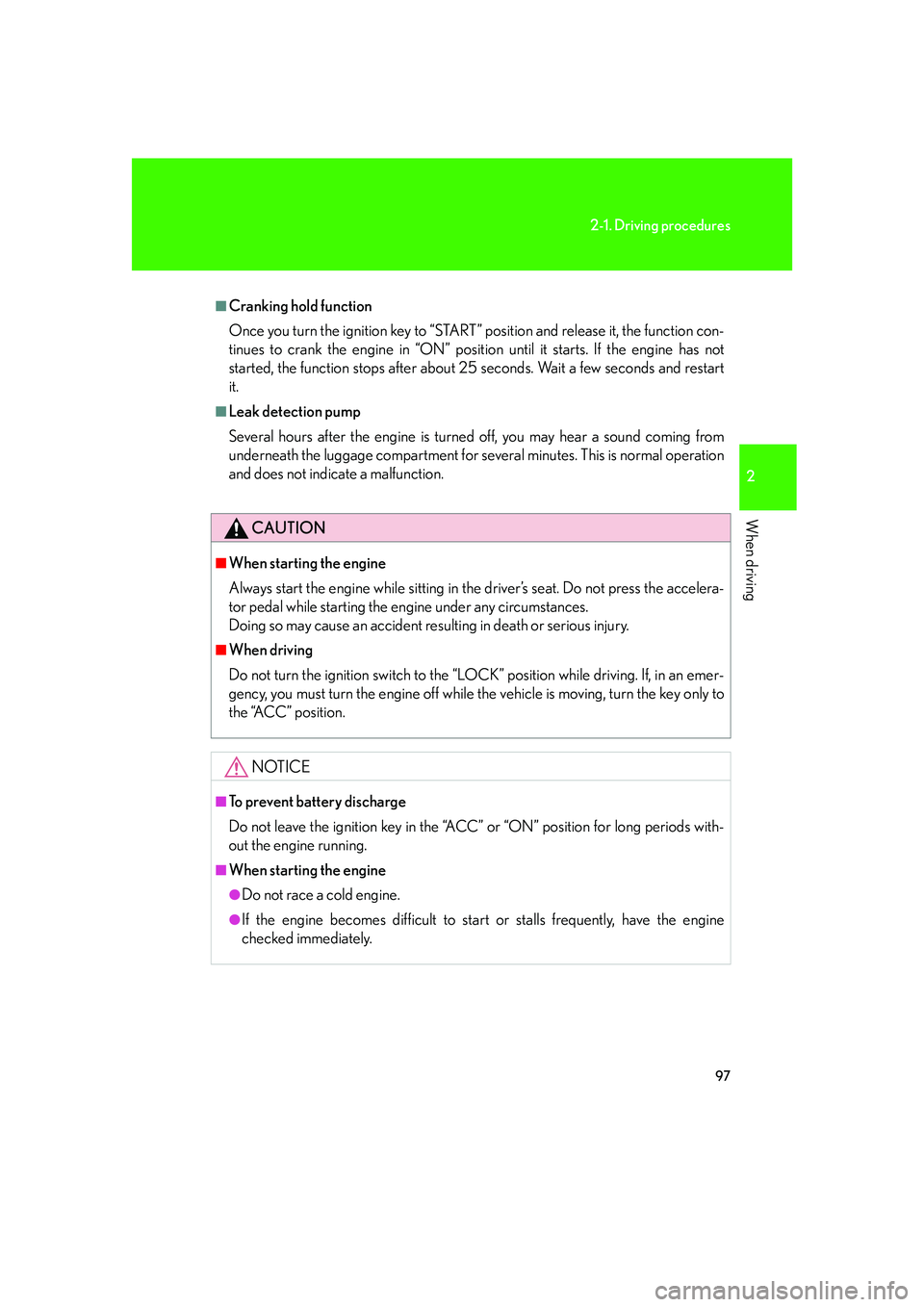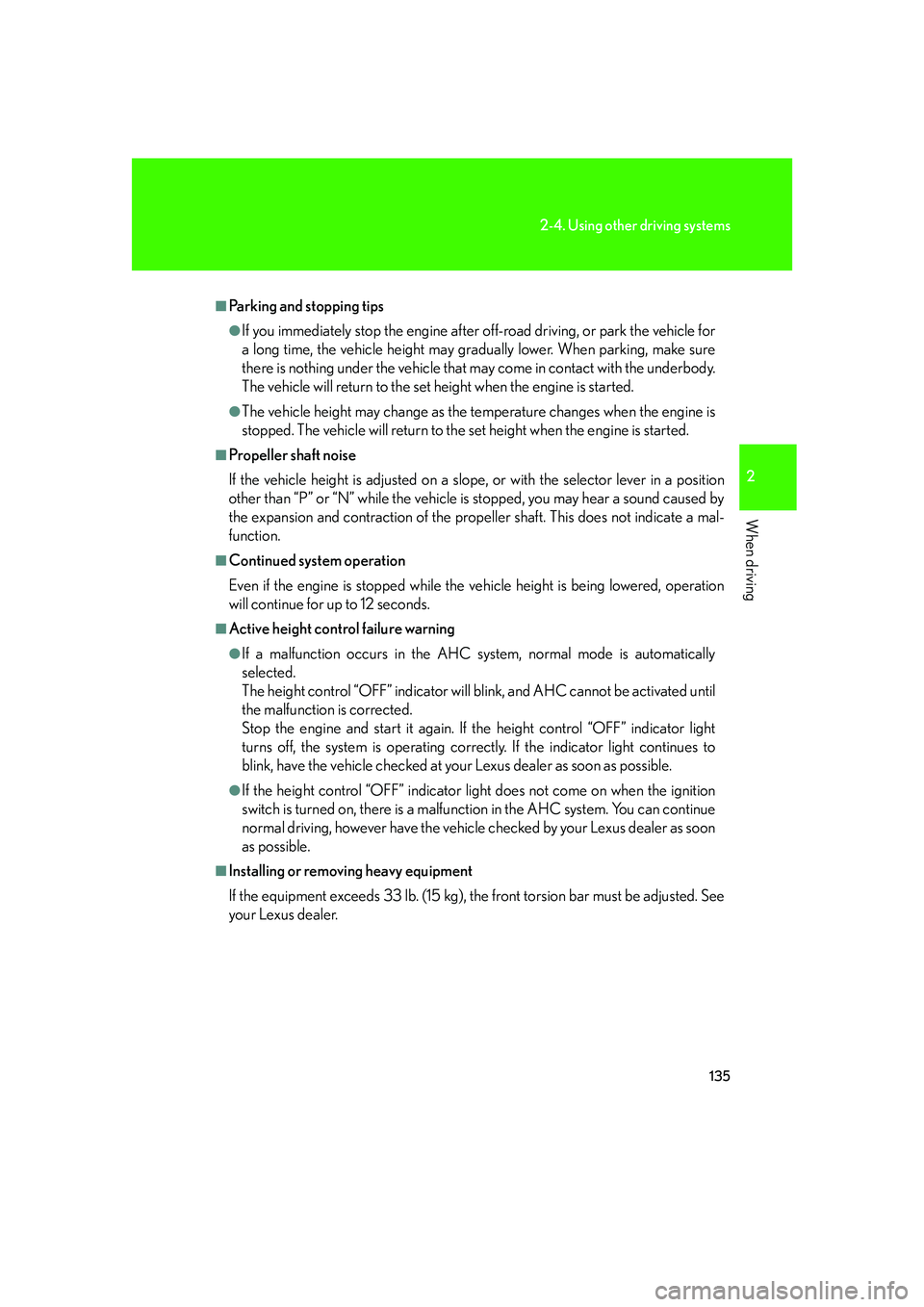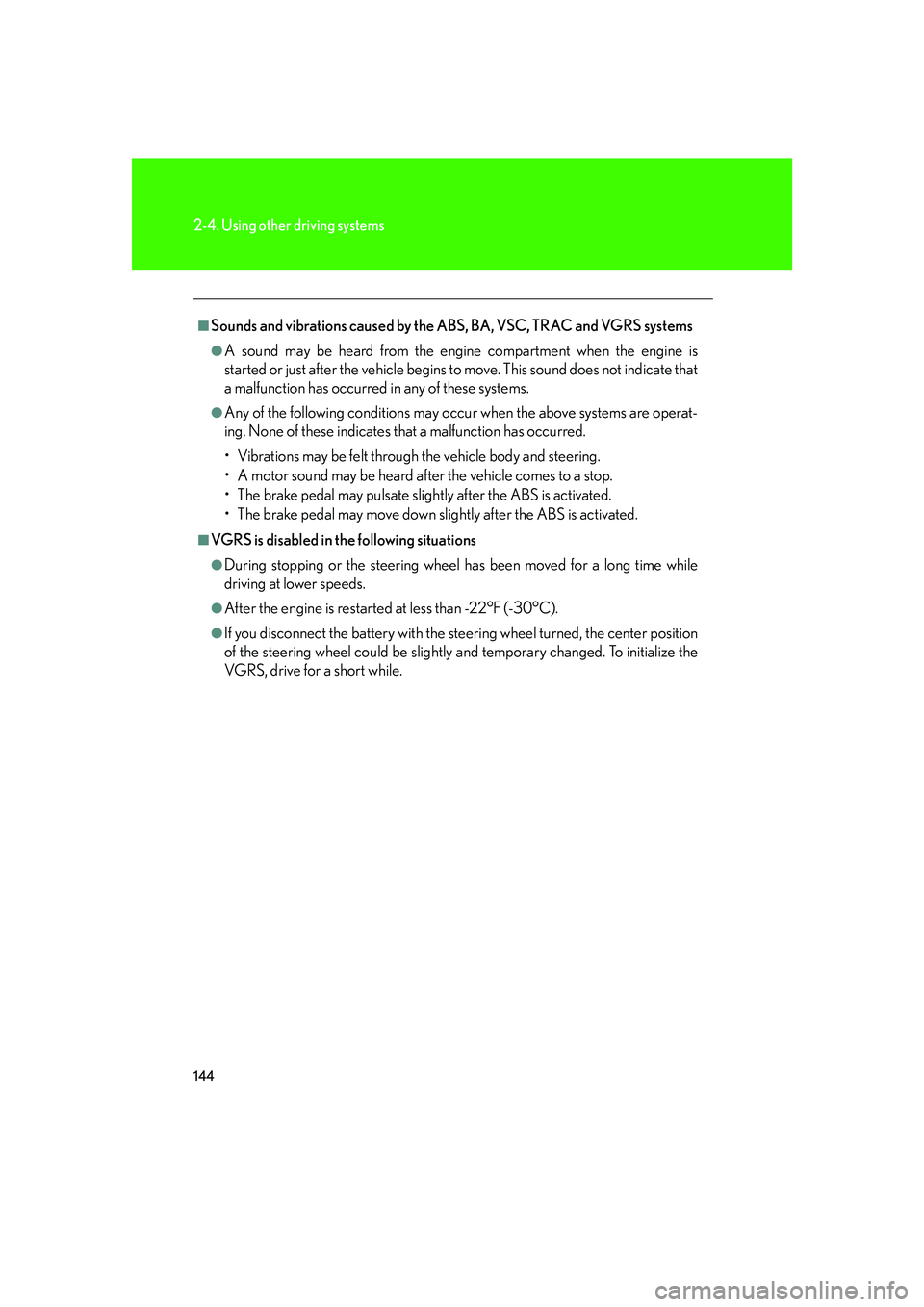stop start LEXUS LX470 2007 Owners Manual
[x] Cancel search | Manufacturer: LEXUS, Model Year: 2007, Model line: LX470, Model: LEXUS LX470 2007Pages: 426, PDF Size: 10.95 MB
Page 53 of 426

35
1-3. Adjustable components
1
Before driving
Turn the upper knobs clockwise to
fix the cross rails to the appropri-
ate length.STEP3
CAUTION
■Cross rail adjustment
Make sure the cross rails are locked securely by pushing forward and rearward
them.
Failure to do so may cause an unexpected accident or severe injury in the event of
emergency braking or a collision.
■When loading cargo
Observe the following precautions.
●Place the cargo so that its weight is distributed evenly between the front and rear
axles.
●If loading long or wide cargo, never exceed the vehicle overall length or
width.(
P. 3 6 8 )
●Before driving, make sure the cargo is securely fastened on the roof luggage car-
rier.
●Loading cargo on the roof luggage carrier will make the center of the vehicle
gravity higher. Avoid high speeds, sudden starts, sharp turns, sudden braking or
abrupt maneuvers, otherwise it may result in loss of control or vehicle rollover
due to failure to operate this vehicle correctly.
●If driving for a long distance, on rough ro ads, or at high speeds, stop the vehicle
now and then during the trip to make sure the cargo remains in its place.
●Do not exceed 143 lb. (70 kg) cargo weight on the roof luggage carrier.
Page 67 of 426

49
1
1-6. Anti-theft system
Before driving
Alarm
The system sounds the alarm and flashes the vehicle lights when an attempt
to steal the vehicle is detected.
■ Triggering of the alarm
The alarm is triggered in the following situations.
●A locked door is unlocked or opened in any way other than using
the wireless remote door lock functi on or key. (The doors will lock
again automatically)
● The hood is opened while the vehicle is locked.
■ Setting the alarm system
Close the doors and hood, and
lock all doors. The system will be
set automatically after 30 sec-
onds.
The indicator light changes from
being on to flashing when the
system is set.
■Deactivating or stopping the alarm
Do one of the following to deactivate or stop the alarm.
● Unlock the doors.
● Start the engine. (The alarm will be deactivated or stopped after a
few seconds.)
Page 106 of 426

88
2-1. Driving procedures
Driving the vehicle
Starting on a steep inclineFirmly set the parking brake and shift the shift lever to “D”.
Gently depress the accelerator pedal.
Release the parking brake.
The following procedures should be observed to ensure safe driving.
■ Starting the engine ( P. 9 5 )
■ Driving
With the brake pedal depressed, shift the shift lever to “D”. (P. 9 8 )
Release the parking brake. ( P. 103)
Gradually release the brake peda l and gently push the accel-
erator pedal to accelerate the vehicle.
■ Stopping
With the shift lever in “D”, push the brake pedal.
If necessary, set the parking brake.
When the vehicle is stopped for an extended period of time, shift the
shift lever to “P” or “N”. (
P. 9 8 )
■Parking the vehicle
With the shift lever in “D”, push the brake pedal.
Set the parking brake. ( P. 103)
Shift the shift lever to “P”. ( P. 9 8 )
Turn the ignition key to stop the engine.
Lock the door, making sure that you have the key on your per-
son.
STEP1
STEP2
STEP3
STEP1
STEP2
STEP1
STEP2
STEP3
STEP4
STEP5
STEP1
STEP2
STEP3
Page 108 of 426

90
2-1. Driving procedures
CAUTION
■When starting the vehicle
Always keep your foot on the brake pedal while stopped with the engine running.
This prevents the vehicle from creeping.
■When driving the vehicle
●Do not drive if you are unfamiliar with the location of the brake and accelerator
pedals to avoid depressing the wrong pedal.
Accidentally depressing the accelerator pedal instead of the brake pedal will
result in sudden acceleration that may lead to an accident that could result in
death or serious injury.
●Do not drive the vehicle over or stop the vehicle near flammable materials.
●Do not let the vehicle roll backwards while the shift lever is in a driving position, or
roll forward while the shift lever is in “R”.
Doing so may cause the engine to stall or lead to poor brake and steering perfor-
mance, resulting in an accident or damage to the vehicle.
●If the smell of exhaust is noticed inside the vehicle, open the windows and check
that the back door is closed.
Large amounts of exhaust in the vehicle can cause driver drowsiness and eventu-
ally, death. Have the cause of the problem inspected immediately.
●Do not under any circumstances shift the shift lever to “P”, “R” or “N” while the
vehicle is moving.
Doing so can cause significant damage to the transmission and may result in a
loss of vehicle control.
●Do not shift the shift lever to “N” while the vehicle is moving.
Doing so may cause the engine brake not to operate properly and lead to an
accident.
●Do not turn the engine off while driving.
The power steering and brake booster systems will not operate properly if the
engine is off.
Page 115 of 426

97
2-1. Driving procedures
2
When driving
■Cranking hold function
Once you turn the ignition key to “START” position and release it, the function con-
tinues to crank the engine in “ON” position until it starts. If the engine has not
started, the function stops after about 25 seconds. Wait a few seconds and restart
it.
■Leak detection pump
Several hours after the engine is turned off, you may hear a sound coming from
underneath the luggage compartment for several minutes. This is normal operation
and does not indicate a malfunction.
CAUTION
■When starting the engine
Always start the engine while sitting in the driver’s seat. Do not press the accelera-
tor pedal while starting the en gine under any circumstances.
Doing so may cause an accident resu lting in death or serious injury.
■When driving
Do not turn the ignition switch to the “LOCK” position while driving. If, in an emer-
gency, you must turn the engine off while the vehicle is moving, turn the key only to
the “ACC” position.
NOTICE
■To prevent battery discharge
Do not leave the ignition key in the “ACC” or “ON” position for long periods with-
out the engine running.
■When starting the engine
●Do not race a cold engine.
●If the engine becomes difficult to start or stalls frequently, have the engine
checked immediately.
Page 149 of 426

131
2-4. Using other driving systems
2
When driving
Vehicle height modesPress “ ▲” to step up one height mode, and “▼ ” to step down one height
mode. (Ex. When in the lo w height mode, press “▲” once to switch to the
normal height mode, and twice to sw itch to the high height mode.)
■ “HI” (high) height mode
Vehicle height is 1.6 in. (40 mm) higher at the front, and 2.0 in. (50
mm) higher at the rear than the normal mode height.
This mode is suitable when driving on bumpy roads or through water.
High height mode is only available when the vehicle speed is under 19
mph (30 km/h).
■ “N” (normal) height mode
The standard vehicle height. This mode is suitable for ordinary driving.
■ “LO” (low) height mode
Vehicle height is 2.0 in. (50 mm) lower at the front, and 1.6 in. (40 mm)
lower at the rear than the normal mode height.
This mode allows easy access to the vehicle.
Low height mode is only availabl e when the vehicle is stopped. When
you start the vehicle, normal height mode is automatically selected.
Conditions for changing the vehicle height mode
Some modes may not be selectable depending on the vehicle speed
when the four-wheel drive control lev er is in the “H” position. Refer to the
following table.
Low modeNormal modeHigh mode
Vehicle stoppedYe sYe sYe s
Under 19 mph (30 km/h)NoYe sYe s
19 mph (30 km/h) or overNoYe sNo
Page 153 of 426

135
2-4. Using other driving systems
2
When driving
■Parking and stopping tips
●If you immediately stop the engine after off-road driving, or park the vehicle for
a long time, the vehicle height may gradually lower. When parking, make sure
there is nothing under the vehicle that may come in contact with the underbody.
The vehicle will return to the set height when the engine is started.
●The vehicle height may change as the temperature changes when the engine is
stopped. The vehicle will return to the set height when the engine is started.
■Propeller shaft noise
If the vehicle height is adjusted on a slop e, or with the selector lever in a position
other than “P” or “N” while the vehicle is stopped, you may hear a sound caused by
the expansion and contraction of the propel ler shaft. This does not indicate a mal-
function.
■Continued system operation
Even if the engine is stopped while the ve hicle height is being lowered, operation
will continue for up to 12 seconds.
■Active height control failure warning
●If a malfunction occurs in the AHC system, normal mode is automatically
selected.
The height control “ OFF” indicator will bl ink, and AHC cannot be activated until
the malfunction is corrected.
Stop the engine and start it again. If the height control “OFF” indicator light
turns off, the system is operating correc tly. If the indicator light continues to
blink, have the vehicle checked at your Lexus dealer as soon as possible.
●If the height control “OFF” indicator light does not come on when the ignition
switch is turned on, there is a malfunction in the AHC system. You can continue
normal driving, however have the vehicle checked by your Lexus dealer as soon
as possible.
■Installing or removing heavy equipment
If the equipment exceeds 33 lb. (15 kg), the front torsion bar must be adjusted. See
your Lexus dealer.
Page 160 of 426

142
2-4. Using other driving systems
Driving assist systems
When the VSC system is operatingIf the vehicle is in danger of slip-
ping, the slip indicator light flashes
and buzzer sounds to indicate that
the VSC systems have been
engaged.
To help enhance driving safety and performance, the following systems
operate automatically in response to various driving situations. Be aware,
however, that these systems are supplementary and should not be relied
upon too heavily when operating the vehicle.
■ABS (Anti-lock Brake System)
Restrains the vehicle from slipping when driving on slick road surfaces or
in the event of sudden braking.
■BA (Brake Assist)
Generates an increased level of braking force after the brake pedal is
depressed, when the system detects a panic stop situation.
■VSC (Vehicle Stability Control)
Helps the driver to control skidding when swerving suddenly or turning on
slippery road surfaces.
■ TRAC (Active Traction Control)
Maintains drive power and prevents the 4 wheels from spinning when
starting the vehicle or accelerating on slippery roads.
■VGRS (Variable Gear Ratio Steering)
Adjusts the wheel turning angle in accordance with the vehicle speed and
steering wheel movement.
Page 162 of 426

144
2-4. Using other driving systems
■Sounds and vibrations caused by the ABS, BA, VSC, TRAC and VGRS systems
●A sound may be heard from the engine compartment when the engine is
started or just after the vehicle begins to move. This sound does not indicate that
a malfunction has occurred in any of these systems.
●Any of the following conditions may occur when the above systems are operat-
ing. None of these indicates that a malfunction has occurred.
• Vibrations may be felt through the vehicle body and steering.
• A motor sound may be heard after the vehicle comes to a stop.
• The brake pedal may pulsate slightly after the ABS is activated.
• The brake pedal may move down slightly after the ABS is activated.
■VGRS is disabled in the following situations
●During stopping or the steering wheel has been moved for a long time while
driving at lower speeds.
●After the engine is restarted at less than -22°F (-30°C).
●If you disconnect the batter y with the steering wheel turned, the center position
of the steering wheel could be slightly and temporary changed. To initialize the
VGRS, drive for a short while.
Page 184 of 426

166
2-5. Driving information
Trailer towing tipsYour vehicle will handle differently when towing a trailer. The 3 main
causes of vehicle-trailer accidents are driver error, excessive speed and
improper trailer loading. Keep the following in mind when towing.
● Before starting out, check the trailer lights and the vehicle-trailer con-
nections. Recheck after driving a short distance.
● Practice turning, stopping and reversing with the trailer attached in an
area away from traffic until you be come accustomed to the feel of the
vehicle.
NOTICE
■When installing a trailer hitch
●Use only the position recommended by your Lexus dealer. Do not install the
trailer hitch on the bumper; this may cause body damage.
●Do not use axle-mounted hitches, as they can cause damage to the axle housing,
wheel bearings, wheels or tires.
■Brakes
Lexus recommends trailers with brakes that conform to all applicable federal and
state/provincial regulations.
■Safety chain
A safety chain must always be used between the towing vehicle and the trailer.
Leave sufficient slack in the chain for turns. The chain should cross under the trailer
tongue to prevent the tongue from droppi ng to the ground in the case that it
becomes damaged or separated. For the correct safety chain installation proce-
dure, ask your Lexus dealer.
■Do not directly splice trailer lights
Directly splicing trailer lights may dama ge your vehicle’s electrical system and
cause a malfunction.